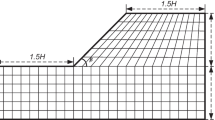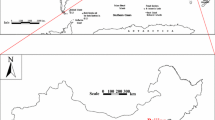Abstract
The factor of safety (FOS) as a technical index, especially adopted in slope engineering, is widely used in the stability evaluation of geotechnical engineering. It is popularly accepted because of its conciseness and straight forward physical meaning. However, very little analysis of this concept has been found for a large scale site involving regional structural geology. In this paper, FOS was introduced into the stability analysis of the site during CO2 injection. To get this FOS, the strength reduction technique was used. In most existing engineering projects, shear failure is the most usual mode in rock mass, but the tensile failure may also occur in certain areas which means that tensile failure should also be taken into consideration in strength reduction methods. Hence a tensile-shear strength reduction method which claims that the tensile strength, friction angle and cohesion should satisfy an inequality during the strength reduction process is put forward. This new strength reduction method was applied to the geological sequestration of CO2 to acquire the FOS of the stratum during the CO2 injection process. What makes this new method unique is that it can be presented with an evolution history of FOS during the whole injection process.
Access this chapter
Tax calculation will be finalised at checkout
Purchases are for personal use only
Preview
Unable to display preview. Download preview PDF.
Similar content being viewed by others
References
Zienkiewiez, O.C., Humpheson, C., Lewis, R.W.: Associated and non-associated visco-Plasticity and Plasticity in soil mechanics. Geostechnique 25(4), 671–689 (1975)
Griffiths, D.V., Lane, P.A.: Slope stability analysis by finite element. Geotechnique 49(3), 387–403 (1999)
Matsui, T., San, K.C.: Finite element slope stability analysis by shear strength reduction technique. Soil and Foundations 32(1), 59–70 (1992)
Wang, D., Zhang, L., Xu, J.: Seismic stability safety evaluation of gravity dam with shear strength reduction method. Water Science and Engineering 2(2), 52–60 (2009)
Cheng, Y.M., Lansivaara, T., Wei, W.B.: Two-dimensional slope stability analysis by limit equilibrium and strength reduction methods. Computers and Geotechnics 34, 137–150 (2007)
Lin, H., Cao, P., Gong, F.: Directly searching method for slip plane and its influential factors. J. Cent. South Univ. Technol. 16, 131–135 (2009)
Dai, Z., Liu, Z., Liu, C.: Numerical analysis of soil slope stability considering tension and shear failures. Chinese Journal of Rock Mechanics and Engineering 27(2), 375–382 (2008) (in Chinese)
Alejano, L.R., Alonsl, E.: Application of the shear and tensile strength reduction technique to obtain factors of safety of toppling and footwall rock slopes. Impact of Human Activity on the Geological Environment, 7–13 (2005)
Lai, J., Fang, Y.: Stability analysis of rock slope with extroversion joint considering tensile strength. Journal of Logistical Engineering University 27(6), 7–12 (2011) (in Chinese)
Streit, J.E.: Estimating fault stability and sustainable fluid pressures for underground storage of CO2 in porous rock. Energy 29, 1445–1456 (2004)
Rutqvist, J., Birkholzer, J.T., Tsang, C.F.: Coupled reservoir-geomechanical analysis of the potential for tensile and shear failure associated with CO2 injection in multilayered reservoir-caprock systems. International Journal of Rock Mechanics &Mining Sciences (2007)
Rutqvist, J., Birkholzer, J., Cappa, F.: Shear-slip anlysis in multiphase fluid-flow reservoir engineering applications using TOUGH-FLAC. In: Proceedings of Tough Symposium (2006)
Rutqvist, J., Wu, Y.S., Tsang, C.F.: A modeling approach for analysis of coupled multiphase fluid flow, heat transfer, and deformation in fractured porous rock. International Journal of Rock Mechanics & Mining Sciences 39, 429–442 (2002)
Morrisa, J.P., Hao, Y., Foxall, W.: A study of injection-induced mechanical deformation at the In Salah CO2 storage project. International Journal of Greenhouse Gas Control 5, 270–280 (2011)
Kogure, T., Aoki, H., Maekadl, A.: Effect of the development of notches and tension crack on instability of limestone coastal cliffs in the Ryukyus, Japan. Geomorphology 80, 236–244 (2006)
Brown, I., Hittinger, M., Goodman, R.: Finite element study of the Nevis Bluff rock slope failure. Rock Mechanics 12, 231–245 (1980)
Kroeger, E.B.: Analysis of plane failures in compound slopes. International Journal of Surface Mining, Reclamation and Enviroment 14, 215–222 (2000)
Paul, B.: Modification of the Coulomb-Mohr theory of fracture. J. Appl. Mech. 28, 259–268 (1961)
Rutqvist, J.: Status of the TOUGH-FLAC simulator and recent applications related to coupled fluid and crustal deformation. Computers & Geosciences 37, 739–750 (2011)
Davis, J.P., Davis, D.K.: Stress-dependent permeability: characterization and modeling. Society of Petroleum Engineers, SPE Paper no. 56813 (1999)
Leverett, M.C.: Capillary behavior in porous media. Trans. AIME 142, 341–358 (1941)
Rutqvist, J., Tsang, C.F.: Tough-Flac: A numerical simulator for analysis of coupled T-H-M processes in fractured and porous geological media under multi-phase flow conditions. In: Proceedings TOUGH Symposium (2003)
Rutqvist, J., Tsang, C.T.: A study of caprock hydrymechanical changes associated with CO2-injection into a brine formation. Environmental Geology 42, 296–305 (2002)
Author information
Authors and Affiliations
Editor information
Editors and Affiliations
Rights and permissions
Copyright information
© 2013 Springer-Verlag Berlin Heidelberg
About this paper
Cite this paper
Yuan, W., Li, X., Bai, B. (2013). The Application of the Strength Reduction Method in Site Stability Analysis of CCS. In: Hou, M., Xie, H., Were, P. (eds) Clean Energy Systems in the Subsurface: Production, Storage and Conversion. Springer Series in Geomechanics and Geoengineering. Springer, Berlin, Heidelberg. https://doi.org/10.1007/978-3-642-37849-2_22
Download citation
DOI: https://doi.org/10.1007/978-3-642-37849-2_22
Publisher Name: Springer, Berlin, Heidelberg
Print ISBN: 978-3-642-37848-5
Online ISBN: 978-3-642-37849-2
eBook Packages: EngineeringEngineering (R0)




